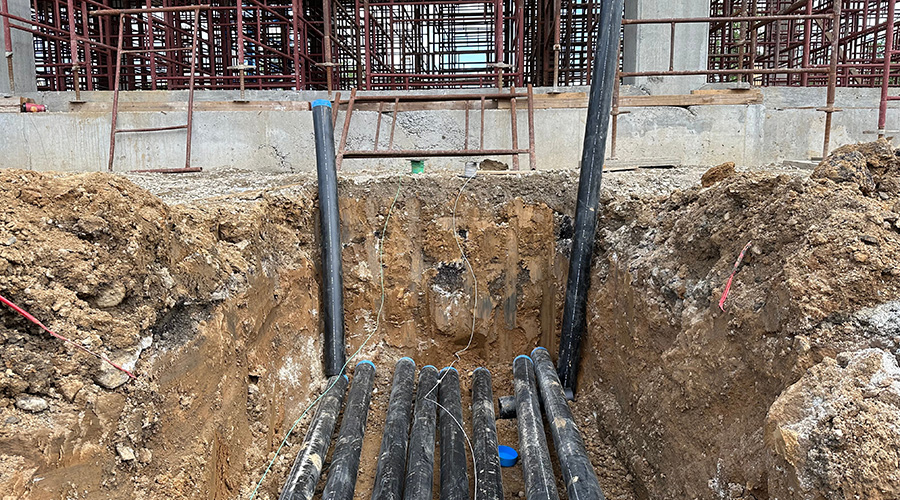« Return to FMDAA entries

Howard County (Md.) Public School System
Being a publicly funded K-12 school system, the Howard County Public Public School System (HCPSS) prides itself on being ranked among the top Maryland school districts. The challenge faced each year is to utilize the limited available funds to make the classroom environment optimal for student learning while maintaining the high level of resources available for the support of instruction.
The deregulated market must be navigated to purchase energy at the most favorable rate, and construction, renovations and preventive maintenance must utilize world-class organizational practices and provide enhanced energy efficiency. An effort, however, must also be made by students and staff at all levels to consume resources wisely so as to make the most of the available funding. As partners in a shared community and global citizenship, HCPSS must also be shown as a good role model to decrease our negative impact on the environment.
Awareness joined with advanced environmental literacy results in more sustainable choices being selected. This applies not just for the end users in the classrooms and offices but also for technicians and designers who operate the equipment and build the classrooms. A balanced and systemwide strategy for sustainability was seen not only as a necessary management decision, but also an essential approach to developing the next generation of energy consumers into successful environmental stewards.
Recent fiscal years have presented budgeting challenges, as well as personnel shortages. An adjustment in focus had to be made to include life-cycle-costing analysis, as well as stakeholder buy-in for the improvement of the environment. Improved environmental literacy campaigns as well as state and federal guidelines raised the bar for construction and renovation projects to be designed at increased levels of efficiency and sustainability. Also, local utility rebates contributed funding to buy down costs and shorten payback periods to levels more fiscally acceptable. And finally, HCPSS partnered with engaged community members, intergovernmental agencies and organizations to encourage, support and reinforce programs, learning and projects.
A formal energy conservation plan was first introduced in September 1996, and the school system has made significant investments in resource conservation over the last two decades. The official plan has matured over time but was originally designed to reduce overall energy consumption and costs. A revised resource conservation plan was presented in 2009 and an updated and expanded sustainability policy was instituted in July 2014 to ensure that HCPSS is an environmentally, economically, and socially sustainable organization.
The sustainability focus at HCPSS includes installation of the most energy-efficient equipment, monitoring of energy usage patterns and behaviors, education of students and staff on energy related technologies, sustainability and environmental literacy, and partnering with our providers to improve our overall energy consumption at the lowest cost.
This systemwide strategy has achieved two main results: a significant decrease in utility consumption and an impactful increase in environmental stewardship.
Decrease in Utility Consumption. In a few short years, the results have been outstanding. Despite opening two new schools, adding several major additions and relocatable classrooms, plus a growing student population that requires advanced technology exposure, FY 2016 gas/electric budgeted costs represent a 40 percent reduction or $7.1 million less than the FY 2010 levels.
While energy costs are at its lowest point in recent history, the energy use intensity in MBtus per square foot also decreased significantly by 13.9 percent. In addition, HCPSS has earned over $3.5 million in rebates and $500,000 in energy incentives through the local electrical grid's peak load management program. Recent energy saving projects include upgrading fluorescent lighting to LED in 12 of the larger buildings — a nearly 4 million kWh savings — replacement of conventional site lighting to LED lamps that are now controlled through the energy management system to control on/off schedules, installation of interval metering to monitor hour by hour consumption at each building, and retro-commissioning of three schools as an ongoing tuneup all of the major heating and cooling equipment. Focus of the retrocommissioning included repair of variable air volume equipment in all spaces, reprogramming equipment for proper intake of outside air ventilation, repair and replacement of variable frequency drives and tune up of all air-handling units.
New construction and renovation produces LEED-certified buildings: Certification or silver certification has been earned by seven elementary schools, two middle schools and one high school; Gold certification eligibility for Ducketts Lane Elementary; and Platinum certification for the new Wilde Lake Middle building, one of only three net-zero-energy schools in Maryland. The state requires a minimum of LEED silver certifications for all new school construction projects, but as a HCPSS standard, we have adopted a policy of LEED certification for all full systemic renovation school construction projects as well.
Increase in Environmental Stewardship: HCPSS is committed to having school and office staff to consider sustainable practices as part of both administrative and curricular practices. The body of student course work includes a wide range of sustainability topics, but as an integral part of encouraging environmental literacy, the school system promotes participation in Green School Certification through the Maryland Association for Environmental and Outdoor Education Program, a voluntary program designed to incorporate local environmental issue investigation and professional development with environmental best management practices and community stewardship.
Within HCPSS, 71 percent of elementary schools, 55 percent of middle schools and 42 percent of high schools for a total of 62 percent of all schools are certified. Additionally, in 2012 HCPSS had its first Green Ribbon School — Dunloggin MS — and in 2015 the district award was given to school system.
Various system wide sustainable practices include:
Comprehensive recycling program in all buildings HCPSS STEM fair: Students present individual research projects for critique by scientists and other community volunteers.
Earlier Environmental Literacy: The HCPSS integrates environmental concepts into science and social studies courses starting in elementary school.
Our Environment in Our Hands: To make sure all HCPSS students are becoming environmentally literate, fourth graders in Title I schools go to a local Living Farm Museum to explore concepts such as stream health, erosion, and Maryland native wildlife.
School Environmental Report Cards: HCPSS students routinely tour their outdoor and indoor school environments to assess factors such as biodiversity, vegetation, erosion, energy use, transportation, and waste management. Students then give their schools an environmental report card, which is shared with the broader community via e-newsletters.
Student Service Learning: HCPSS middle and high schools routinely incorporate environmental learning into their student service learning projects. Topics for middle school projects have included air quality, ecology of the bay, ecological footprints, energy consumption, native species restoration, and stream restoration.
Summer Institutes for Talent Development: The HCPSS offers hands-on environmental learning opportunities for students during the summer break. Many of these programs focus on environmental learning; one class explores topics such as green roofs, offshore drilling, and biodiversity.
Explore and Restore Your SchoolShed Initiative: An initiative of Maryland Governor Martin O’Malley, Explore and Restore Your SchoolShed motivates participating schools to explore and care for their local streams.
Maryland Environmental Literacy Partnership (MELP): The HCPSS serves as the lead school system in this eight-school partnership that includes support from the Chesapeake Bay Foundation. HCPSS schools participate in MELP’s Issues Investigation Framework, which is aligned with the Next Generation Science Standards.
Green Cleaning Award: The HCPSS was selected as the Grand Award Winner among K-12 school districts in this Schools & Universities competition, sponsored by American School & University magazine, The Green Cleaning Network, and Healthy Schools Campaign.
Green Seal GS-42 Certification: The HCPSS was the nation’s first public school system to achieve the Green Seal GS-42 certification for cleaning and contributing to a healthy and more sustainable environment HCPSS is also is partnering with Howard County Government to collect food scraps at seven schools with future expansion.
In-house Participants: Diane Sweeney, Larry Phillips, Tony Bonomo, John Duvall.
Additional Information
Ecology Services/Howard County Landfill Services » (pdf)
Green Seal Certification Letter » (pdf)
↑ Back to top








